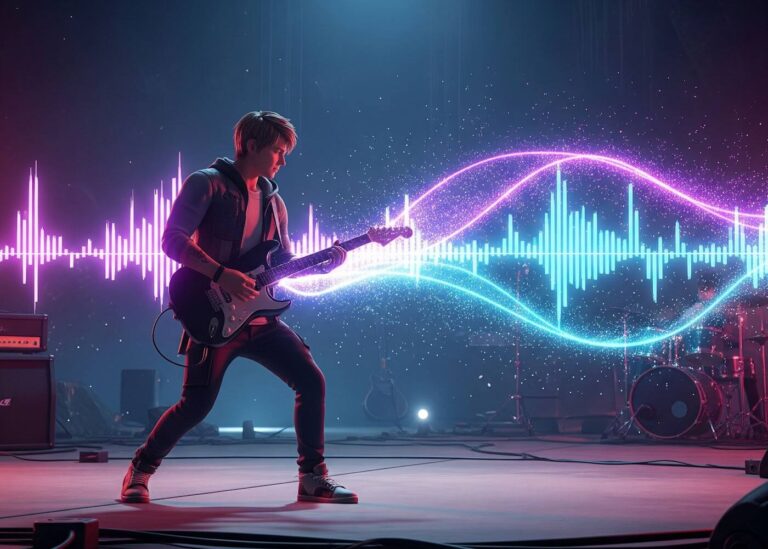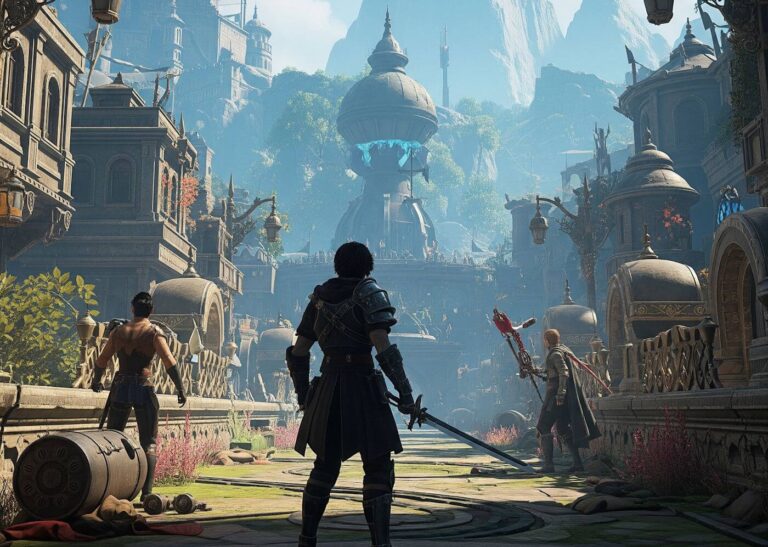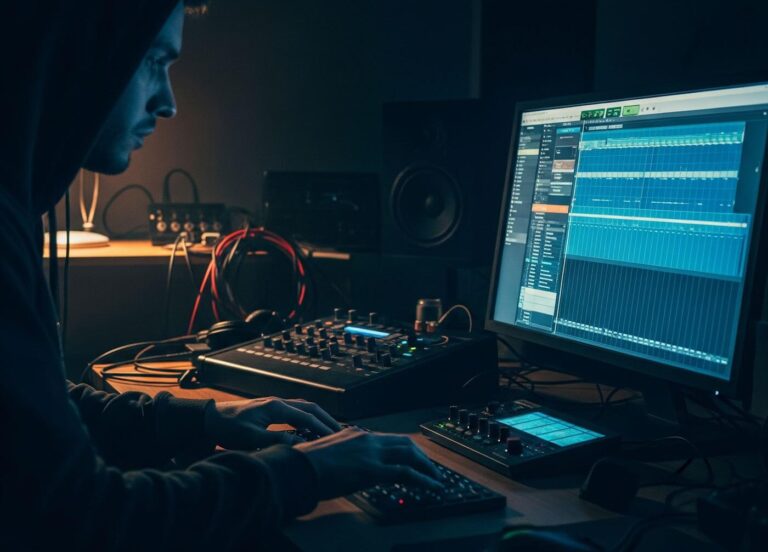Can Bad Music Ruin a Masterpiece Game?
Introduction: The Synergy of Music and Gaming
The intricate relationship between music and video games has been an influential component in shaping players’ experiences and enhancing gameplay. Music in gaming serves as more than just background noise; it is a pivotal element that can encapsulate the game’s atmosphere, driving the emotional undertones of the experience. A compelling soundtrack has the power to immerse players in intricate worlds, making them feel as though they are part of a living, breathing environment.
When examining this synergy, one must consider how game developers utilize music to enhance storytelling and gameplay dynamics. For instance, an upbeat tune during a race can instill a sense of adrenaline and excitement, while a haunting melody in a horror game can amplify feelings of tension and unease. By effectively using music, developers can trigger emotional responses that elevate the overall gaming experience, providing players with memorable moments that resonate long after the game is over.
However, it is essential to recognize that not all musical compositions achieve this harmonious integration. While a game might excel in graphics and gameplay mechanics, poor music can detract from what could otherwise be a masterpiece. An ill-fitting soundtrack may disrupt the player’s immersion, drawing attention away from the game’s narrative and mechanics. As such, it can impede emotional engagement and diminish the sense of connection players feel towards the game’s characters and storyline. This highlights the crucial role that music plays in not just enriching a game but in defining its quality and impact on players. The balance and synergy between music and gaming are paramount in creating a holistic experience that resonates with players on multiple levels.
The Role of Soundtracks in Gaming
Soundtracks play a pivotal role in the gaming experience, functioning as an essential element that significantly enhances player immersion. The right music can transport players to alternate realities, influencing their emotional responses and engagement with the game’s narrative. In many instances, the soundtracks draw players deeper into the storyline, creating a synergy between audio and visual elements that enhances the overall experience.
Different gameplay scenarios often necessitate specific musical styles to evoke appropriate emotions. For instance, during intense combat sequences, a fast-paced, orchestral score can heighten feelings of adrenaline and urgency. Conversely, in moments of exploration or reflection, softer, ambient music can provide players with a sense of calm and encourage exploration. This versatility illustrates how music not only complements visual storytelling but also drives the pacing of a game, facilitating a connection between players and the virtual world.
Several notable games exemplify the profound impact of soundtracks on player experience. One of the most acclaimed examples is “The Last of Us,” where the haunting melodies by Gustavo Santaolalla underscore the emotional weight of the narrative, solidifying the game’s reputation as a masterclass in storytelling. Similarly, “Journey” showcases how a dynamic soundtrack can adapt to players’ actions, creating a unique auditory experience that amplifies the game’s emotional landscape. The collaboration between sound and gameplay mechanics is evident, further supporting the notion that an adept soundtrack can elevate a game from merely enjoyable to a critically acclaimed masterpiece.
In essence, the function of soundtracks in gaming goes far beyond mere background noise; they are integral to the gaming experience, enhancing immersion and emotional depth, thereby positively influencing the game’s overall perception and success.
The Impact of Bad Music on Player Experience
The influence of music in video games is profound, often serving as a fundamental pillar that enhances the emotional and atmospheric dimensions of gameplay. However, when the music fails to align with the game’s aesthetic or narrative, it can detract significantly from the player experience. Bad music, characterized by dissonance, jarring melodies, or overly repetitive tracks, has the potential to disrupt immersion, leading to frustration and dissatisfaction among players.
One of the critical aspects of video game music is its ability to evoke emotions that resonate with the player’s actions and decisions. In instances where the soundtrack contains dissonant elements or conflicting themes, it can create an experience that clashes with the gameplay. This dissonance not only distracts players but may also lead to a heightened sense of cognitive disconnection between gameplay and auditory cues, isolating the player from the immersive experience that well-composed music is meant to provide.
Moreover, jarring melodies can interrupt the flow of gameplay, drawing attention away from the game’s narrative and mechanics. Players may find themselves irritated by oddly timed musical cues or shifts in tempo that fail to sync with key moments in the game. As a result, this can foster a negative perception of the game as a whole, overshadowing the artistry in design, storytelling, and gameplay mechanics—elements that might otherwise be celebrated. Additionally, overly repetitive tracks can contribute to monotony; when players are exposed to the same loop for too long, it can culminate in disengagement and emotional fatigue, reducing their overall enjoyment.
In summary, the ramifications of bad music in video games extend beyond mere distraction; they can fundamentally alter player experiences, influencing how games are perceived and enjoyed. A well-composed score is crucial to maintaining engagement, enhancing the immersion that resonates deeply with players throughout their journey. Thus, developers should prioritize musical quality to ensure that it complements their gaming masterpieces.
Case Studies: Games with Great Gameplay but Bad Music
In the video game industry, the harmony between gameplay and music plays a crucial role in shaping the overall player experience. While some titles achieve a seamless integration of these elements, others encounter the challenge of offering exceptional gameplay accompanied by less-than-stellar music. This section explores notable examples where the music did not meet the high expectations set by their gameplay mechanics.
One prominent title is “Dead Space.” Critically acclaimed for its intense gameplay and immersive storytelling, “Dead Space” showcased a terrifying atmosphere that kept players on edge. However, many players criticized the soundtrack, stating that it failed to complement the tension created during gameplay. The repetitive nature of certain tracks detracted from the overall experience, causing players to feel less engaged in the horror elements. While the gameplay received widespread praise, the disappointing music left some players feeling that it overshadowed the otherwise masterful design.
Another example is “Bioshock Infinite,” which was celebrated for its thought-provoking narrative and unique gameplay mechanics. Despite its accolades, the game’s score was met with mixed reviews. Critics pointed out that the music, rather than enhancing the experience, often felt disjointed or poorly timed. The juxtaposition of gameplay and score diminished moments that could have been heightened through more fitting audio choices. Some players noted that the musical elements were forgettable, which, in turn, affected their overall appreciation of the title.
Lastly, “Assassin’s Creed III” serves as an example of a title with both innovative gameplay and an underwhelming score. While the open-world exploration and historical settings garnered commendation, the soundtrack did not resonate with many players. Critics argued that it lacked emotional depth, contributing to a dissonance that affected how players connected with the storyline, illustrating the impact that poor musical integration can have on an otherwise successful game.
Contrasting Examples: Games with Soundtracks that Elevate Experience
Music is an integral component of video games, often transcending mere background noise to become a vital element that shapes player experiences and emotions. In numerous titles, soundtracks have been carefully crafted to enhance storytelling, evoke feelings, and complement gameplay mechanics. Notable examples illustrate how unforgettable scores can elevate the experience of a game and leave a lasting impression on players.
One prominent example is the score from The Legend of Zelda: Ocarina of Time. Composed by Koji Kondo, its melodic themes are intrinsically tied to the journey of Link as he travels through a richly detailed world. The Ocarina of Time itself becomes a gameplay mechanic, with music actively influencing the progression of the story. As players engage with various characters and traverse diverse environments, the soundtrack subtly guides emotional responses, heightening moments of adventure, nostalgia, and even tension.
Another noteworthy title is Journey, developed by Thatgamecompany. Its dynamic score, composed by Austin Wintory, responds fluidly to players’ movements and actions within the beautifully rendered desert landscape. The music collaborates with visual elements to forge a profound emotional connection, helping to convey themes of exploration and companionship. This organic integration of audio and gameplay mechanics exemplifies how a well-composed soundtrack can amplify the player’s emotional journey.
Furthermore, NieR: Automata stands out with its evocative score, which seamlessly blends orchestral and choral elements. The music not only serves as an accompaniment to gameplay but also deepens the narrative complexity explored through the game’s themes of identity and existentialism. As players delve into the intricate storylines, the resounding score intensifies the overall experience, creating poignant moments that resonate well beyond gameplay.
These examples demonstrate that a meticulously designed soundtrack can serve as more than just an auditory backdrop; it can significantly enhance the emotional depth and immersive quality of video games. With music playing such a crucial role, the potential for soundtracks to elevate the gaming experience remains a compelling aspect of game design.
Player Preferences: Subjectivity in Music Appreciation
Music is an inherently subjective experience, shaped by individual tastes, cultural backgrounds, and personal experiences. When it comes to video games, players often have strongly held opinions about the soundtracks that accompany their virtual experiences. For some, a game’s music can enhance immersion, heighten emotional responses, and even influence gameplay. However, others might find these same musical elements off-putting or inappropriate for the game’s atmosphere. This variability raises an interesting point about the role of music in gaming: not only does it serve as an auditory backdrop, but it also evokes a diversity of reactions based on player preferences.
Factors such as genre affinity play a significant role in how a player perceives and enjoys a particular soundtrack. For instance, a fan of orchestral compositions may appreciate a score filled with sweeping melodies and grand arrangements, while others drawn more to electronic beats might find such music uninspired or overly traditional. Similarly, cultural references embedded within game scores can resonate differently across player demographics, adding another layer of complexity to the appreciation of music in gaming contexts.
Furthermore, nostalgia can influence opinions about a game’s soundtrack. Players who have fond memories associated with a specific musical theme or composition may experience a heightened appreciation for it, regardless of its technical merits. This emotional connection can sometimes overshadow more objective assessments of quality, highlighting that player preferences are often deeply personal and influenced by various external factors. Thus, while some may criticize a soundtrack for its lack of depth or innovation, it is essential to acknowledge that taste in music is idiosyncratic. What may be off-putting to one player could easily be a source of delight for another, underlining the complex interplay between personal preferences and the world of video game music.
The Role of Dynamic Music in Gaming
Dynamic or adaptive music plays a crucial role in enhancing the gaming experience by responding to players’ actions and the unfolding narrative. This form of music is designed to change in real-time, allowing for a more immersive and engaging environment. When executed well, dynamic music can amplify the emotional resonance of a scene, intensify combat sequences, or even provide subtle cues about the game’s direction. A quintessential example of effective dynamic music can be seen in the game “The Legend of Zelda: Breath of the Wild.” Here, the score seamlessly transitions between serene melodies and intense tracks that heighten the thrill of exploration and combat, capturing the essence of the adventure.
Conversely, poor implementation of dynamic music can detract from the gaming experience. A game may employ a dynamic soundtrack that becomes repetitive or fails to align with the gameplay, leading to a disjointed experience. For instance, if a game’s music shifts abruptly without considering player actions or emotions, it can break immersion and distract from the otherwise rich narrative or gameplay mechanics. An example of scant dynamic musical integration can be noted in several early-generation titles, where music loops failed to adapt to player interactions, resulting in a monotonous auditory backdrop that risked diminishing player engagement.
The impact of dynamic music on gameplay experience is profound; it highlights the need for composers and game developers to thoughtfully consider musical elements in design. The potential for dynamic music to elevate a gaming masterpiece is immense, as seen in both celebrated successes and unfortunate failures. Therefore, striking the right balance is essential, as it can either enhance or undermine the immersive quality of the game.
Future Trends in Video Game Music Production
The landscape of video game music production is rapidly evolving, influenced by advancements in technology and the shifting expectations of players. One of the most notable trends is the collaboration between game developers and famous musicians. These partnerships have started to yield soundtracks that not only enhance the gaming experience but also reach beyond the interactive medium, appealing to broader musical audiences. Iconic artists are increasingly contributing their talents to game soundtracks, enriching the auditory palette and fortifying the emotional connection between players and gameplay.
Another prominent development in video game music production is the integration of advanced technologies such as artificial intelligence and machine learning. These technologies allow for adaptive soundtracks that can react dynamically to in-game events. This form of music composition enhances player immersion, as the background score evolves alongside the player’s actions and decisions. Furthermore, the use of spatial audio techniques aims to create a more three-dimensional auditory experience, anchoring players deeper into the game world.
As players grow more discerning and demanding in their expectations, the future of video game music production will likely focus on personalization and uniqueness. Developers may explore user-generated content where players can create and implement their own music into games. This adaptability can cater to diverse tastes, providing players with a unique soundtrack tailored to their preferences. Additionally, the inclusion of live orchestras and live-performances, either within the game or as part of promotional events, could become a common practice as developers strive to elevate the gaming experience.
Ultimately, these trends suggest a significant shift in how soundtracks are created and perceived within the gaming community. As technology continues to advance and collaborations expand, the potential for innovative sound design in video games is vast, thus permanently transforming player expectations towards a richer, more engaging auditory experience.
Conclusion: Finding Harmony in Game Design
In the realm of video games, the significance of music cannot be overstated. It serves not only as an auditory backdrop but also as a crucial element that can enhance or detract from the overall gaming experience. The integration of sound and gameplay is essential; a well-crafted soundtrack has the potential to immerse players in the game’s narrative, evoke emotions, and reinforce the atmosphere. On the contrary, a poorly executed musical score can disrupt this harmony, leaving players feeling disconnected and disengaged.
Game developers are encouraged to prioritize their audio design as they approach game development. The alignment of music with the gameplay mechanics and narrative structures ensures that players remain absorbed in their virtual adventures. Whether it is a serene melody accompanying an exploration phase, or an adrenaline-pumping score during peak action moments, the cohesive integration of sound is fundamentally important. Titles with a lack of attention to this element risk overshadowing their intricate designs, captivating graphics, and compelling storylines.
Moreover, the rise of independent game development has revealed a growing awareness of the impact of music within the gaming community. As developers strive for unique experiences, many are taking bold steps to curate soundtracks that resonate with players. This trend not only highlights the evolving landscape of audio design in gaming but also suggests that sound plays an ever-critical role in ensuring that even the most masterful gameplay is not undermined by inadequate musical accompaniment.
To achieve an optimal gaming experience, it is imperative to strike a balance between music and interactive elements. In conclusion, embracing the power of sound in game design will facilitate a more harmonious relationship between gameplay and music, ultimately leading to richer and more engaging player experiences.







